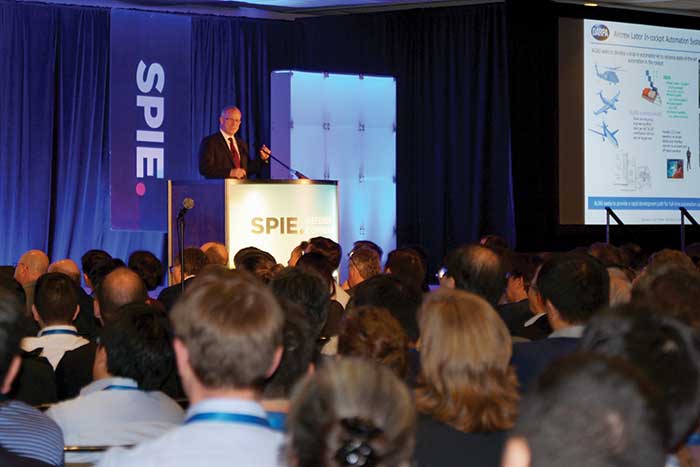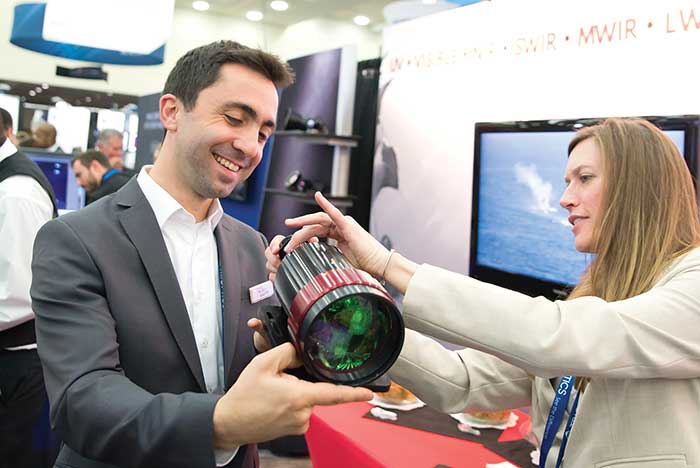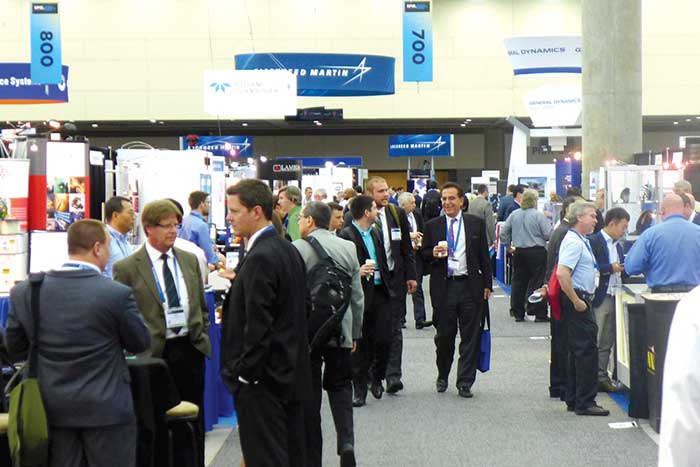Changes in the nature of warfare in today’s high-tech world demand the most advanced tools for soldiers and others in the defense and security sectors. Environmental and health care segments are evolving, too, as an onset of innovative technologies is improving medical care and environmental monitoring. SPIE’s annual Defense + Commercial Sensing (DCS) event — to be held this year in Anaheim, Calif., from April 9 to 13 — brings such advancement into focus.

Courtesy of SPIE.
“In recent years the imaging and sensing market has exploded as consumer applications have emerged, leveraging technologies traditionally developed for the industrial, defense and security markets,” said Andrew Brown, senior director at SPIE. “Future growth will be fueled by applications in new areas such as lidar for autonomous vehicles, wearable sensors, the internet of things, agriculture, and food safety and water quality assurance. SPIE Defense and Commercial Sensing, with its focus on real-world applications, attracts leaders from industry, government and the research community to explore the latest developments in sensing and imaging and to promote the transition of technologies from the research lab to end markets.”
The DCS annual conference and exhibition — touted a leading global event in the photonics industry — takes innovative sensing, imaging and other photonics technologies and products to new heights for applications in defense, security, health care and the environment. Through focused topical tracks, technical programs, plenary sessions, courses and research presentations, DCS highlights technical advances in sensors, infrared technology, laser systems, spectral imaging, radar, lidar and more. A job fair and exhibition will feature companies from around the world.
“The 380-company exhibition will feature some of the world’s leading companies showcasing their products and services. This is the largest showcase for infrared cameras at every price point, spectroscopic sensing, and fiber optics for lightguides, inspection, and sensing systems,” Brown said.
Technical programs
Defense + Security is one of two technical programs at DCS. It focuses specifically on sensors, imaging and optical technologies for security, law enforcement, avionics and aerospace, defense and military applications.
Another DCS technical program is Commercial + Scientific Sensing and Imaging. This offers sessions on sensors, imaging and image processing, and photonics technology innovations for agriculture, manufacturing, health care, pharmaceutical, transportation, information systems and environmental applications.
Plenaries, courses & tracks
Three focused topical tracks will cover much ground in unmanned autonomous systems (UAS), agriculture and fiber optic sensors.
The UAS segment offers a look at the latest research for enhancing air, ground and underwater UAS such as lidar, infrared, and multispectral and hyperspectral imaging. Several industry sessions will be held, as well, within this track. Among them:
• Lidar for Autonomous Vehicles: The Future of 3D Sensing and Perception
• Technological Breakthrough in Lidar Technology: Taking Fully Autonomous Driving to the Masses
• The Industrial Impacts of Thermal Imaging Drones
• High-Speed Imaging: Today’s Possibilities and Future Directions
A number of conferences held within the Defense + Security technical program relate to UAS, including Unmanned Systems Technology, Laser Radar Technology, Sensors and Systems for Space Applications, and Next Generation Analysts. In the Commercial + Scientific Sensing and Imaging technical program, subconferences include Thermosense: Thermal Infrared Applications, and Autonomous Air and Ground Sensing Systems for Agricultural Optimization and Phenotyping.

Courtesy of SPIE.
The agriculture track allows attendees to explore sensing, imaging and related photonics technologies for agricultural and food safety and quality applications, such as unmanned aerial vehicles (UAVs), hyperspectral imaging, phenotyping and infrared thermography. Such applications will be the focus of several sessions, as well — Photonics and Food: Optical Tools Tackle Food Safety Challenges; Miniaturized and Mobile Spectroscopy and Optical Sensor Applications; and Infrared Applications: ThermoSense XXXIX.
Fiber optic sensors are the emphasis of the third track. Experts in this field will discuss the different aspects of fiber optic sensor technology based on conventional and specialty optical fibers, including photonic crystal fibers and metalized fibers, for aerospace, civil structures, defense, medical and environmental applications. A related subconference — Fiber Optic Sensors and Applications XIV — offers sessions that concentrate in these and other related areas.
DCS will host two top industry players in 2017 for plenary presentations — Thomas J. Burns, director of the Strategic Technology Office at the Defense Advanced Research Projects Agency, and Parker Abercrombie, Immersive Visualization Project lead for NASA’s Jet Propulsion Laboratory. The plenary presentations will cover much ground, focusing on “game-changing technology and valuable insights” for the defense, security and environmental sectors.

Courtesy of SPIE.
In addition, an extensive series of courses will cover IR sensors and systems, optics and optomechanics, imaging and sensing, quantum radiometry, lasers and more.
“SPIE Defense + Commercial Sensing will provide a valuable experience for those already working in the field or who want to gain an understanding of the technology and markets driving this rapidly advancing sector,” Brown said.
SPIE 2017 Fellows
The society has announced the Fellows of 2017 — 71 in total — who join more than 1200 others chosen since the SPIE’s inception in 1955. They are chosen based on their significant scientific and technical contributions in the multidisciplinary fields of optics, photonics and imaging, as well as service to SPIE and the greater optics and photonics community.
“[In 2017] they represent 16 countries on three continents, and 13 of the 71 are women, which represents an all-time high for a single year,” said Majid Rabbani, 2016 chair of the SPIE Fellows Committee, and a professor at Rochester Institute of Technology’s Kate Gleason College of Engineering. “Their affiliations encompass the full range of academia, industry and government labs and institutes, with expertise spanning all aspects of the photonics community, including strong representation from the medical imaging community.”
Rabbani noted that the new fellows are recognized at SPIE meetings of their choice throughout the year. Several are expected to be acknowledged at DCS.
Rising Researchers
DCS features presentations by Rising Researchers, a series that recognizes “early career professionals who are conducting outstanding work in product development or research in the defense, commercial and scientific sensing, imaging, optics or related fields.” According to SPIE, Rising Researchers provides personal recognition, while enriching further professional growth and networking opportunities.
These researchers work in various disciplines such as defense and security, nanotechnology, electronic imaging and signal processing, optical design and engineering, remote sensing, and biomedical optics. Also, medical imaging will be recognized this year.
Defense & Security
Nathan Cahill, Rochester Institute of Technology
Daniel LeMaster, Air Force Research Laboratory
Nanotechnology
Matt Graham, Oregon State University
John Hennessy, NASA Jet Propulsion Laboratory
Yongmin Liu, Northeastern University
Electronic Imaging & Signal Processing
Daniela Moody, Descartes Labs
Shuo Pang, University of Central Florida
Optical Design & Engineering
Junsuk Rho, Pohang University of Science and Technology
Remote Sensing
Adrian Tang, UCLA and NASA Jet Propulsion Laboratory
Biomedical Optics & Medical Imaging
Fei Tian, Stevens Institute of Technology
The Rising Researchers are chosen based on their potential long-term contribution to sensing, imaging, optics, photonics and related fields, as well as their work’s role in the scientific, educational or economic impact of optics and photonics.